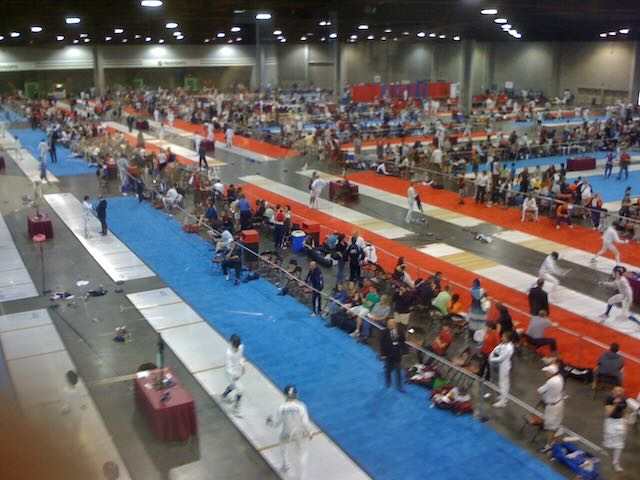(Nostalgia for those preparing for yet another SN)

These days I usually don’t think much about fencing tournament logistics, having been out of that business now for the better part of a decade, but my husband just had his second total knee replacement early this week, and I’m cognitively in a weird place, somewhat reminiscent of working long BC hours at Summer Nationals, back when tournament operations left much to be desired.
This morning I woke up thinking about the worst SN I ever worked as BC chair. Took me a bit of research to figure out which SN it was, because the part haunting me was specifically the strip layout, but my vague impression that it was at the Georgia World Congress Center was correct: Atlanta 2010.
Come with me now back to the Bad Old Days, before the feather banners marked pods, back when we numbered all the strips consecutively, and didn’t even routinely use pods of four strips.
I don’t have a copy of the map, so we’ll have to get by with a paragraph from my blog post for that setup day (https://marygriff.com/2010/07/09/bc-diary-day-0/):
At the bout committee stage there are stacks of the strip map sitting on the tables, so I grab a copy to see what we’ll have to work with. Looks like nine pods of four strips—oops, no, the one in the corner is really only two strips plus the wheelchair frames. The other half of the hall is an assortment of twos and threes, but I can’t see what the pattern is—2, 3, 2, 2, then the BC stage and the trainers, then 2, 3. The next section is 3, 2, 2, 2, the Finals area, and another 3. Sixty strips total, plus the Finals strip. But two of the three-pods each have one of the “banana” strips, the congenitally curved strips that tend to come apart when people fence on them, and four other strips are roll-out cloth strips that we shouldn’t put epee or large people on.
BC chairs tend to think in multiples of four strips—ideally, we want to put direct elimination rounds out on 8, or 16, or 24 strips, as much as we can on the same strips used for the pool rounds. At huge events like SN, I normally learned the map really quickly, knowing which part of the room the two pods of strips 17–24, say, were located. But this particular layout was nearly impossible to learn, because of that pesky layout. Strips 1–4 were not a pod unto themselves; the first two strips were shared with those wheelchair frames, so the four-pods were weirdly 3–6, 7–10, 11–14, etc.
And then there was the other half of the hall, with all those twos and threes randomly distributed. It was impossible to assign strips without constantly referring to the map to figure out what was where.
That was the single most exhausting SN I ever worked, and we BC/TC folks yelled about it quite a bit afterward. The following season we pretty much moved to four-pods exclusively, and we began to experiment with better strip numbering. I think we had a couple of NACs where we numbered the pods and gave the strips within each pod letters (e.g., 1A, 1B, 1C, 1D), and then someone—I can’t remember who—suggested lettering the pods and numbering the strips within the pod, and the national office eventually ordered those nifty feather banners and we could retire our worn laminated office-paper strip numbers.
There’ve been lots of other improvements, too, obviously, not least of which was the replacement of the once-miraculous XSeed tournament software that Dan McCormick had written with Dan Berke’s FencingTime. (Remember back before live results on your phone there were just the monitor screens in the venue, and before that, only those damn wobbly bulletin boards where BC staff posted paper copies of all the assignments and tableaux, and there was another area where we posted the paper results. Sometimes the local organizing committee was even organized enough to make copies of the results so people could buy copies for themselves.)
I looked up the entry numbers for that 2010 SN in Atlanta: amazingly, there were about 6,270 individual entries in what was then considered an excessively large SN. Last year’s SN in Minneapolis, with over 9,000 individual entries, had nearly half again as many. And it was a lot easier to find your strip than it used to be.



 So for 1998, I wrote another one,
So for 1998, I wrote another one, 